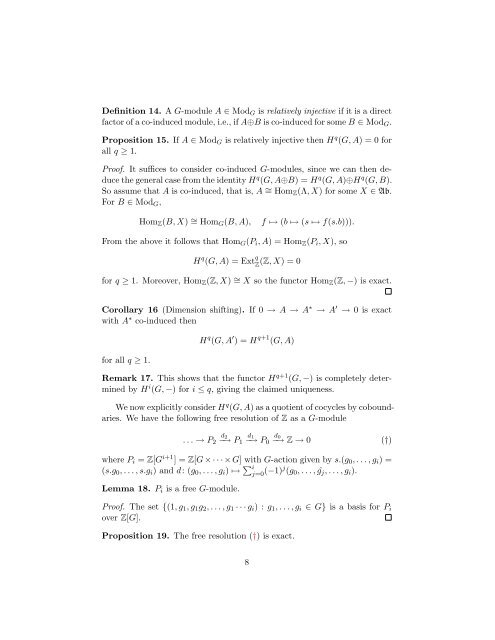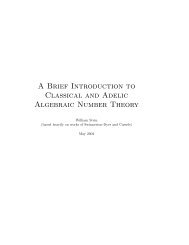A Short Course on Galois Cohomology - William Stein - University of ...
A Short Course on Galois Cohomology - William Stein - University of ...
A Short Course on Galois Cohomology - William Stein - University of ...
Create successful ePaper yourself
Turn your PDF publications into a flip-book with our unique Google optimized e-Paper software.
Definiti<strong>on</strong> 14. A G-module A ∈ ModG is relatively injective if it is a direct<br />
factor <strong>of</strong> a co-induced module, i.e., if A⊕B is co-induced for some B ∈ ModG.<br />
Propositi<strong>on</strong> 15. If A ∈ ModG is relatively injective then H q (G, A) = 0 for<br />
all q ≥ 1.<br />
Pro<strong>of</strong>. It suffices to c<strong>on</strong>sider co-induced G-modules, since we can then deduce<br />
the general case from the identity H q (G, A⊕B) = H q (G, A)⊕H q (G, B).<br />
So assume that A is co-induced, that is, A ∼ = HomZ(Λ, X) for some X ∈ Ab.<br />
For B ∈ ModG,<br />
HomZ(B, X) ∼ = HomG(B, A), f ↦→ (b ↦→ (s ↦→ f(s.b))).<br />
From the above it follows that HomG(Pi, A) = HomZ(Pi, X), so<br />
H q (G, A) = Ext q<br />
Z (Z, X) = 0<br />
for q ≥ 1. Moreover, HomZ(Z, X) ∼ = X so the functor HomZ(Z, −) is exact.<br />
Corollary 16 (Dimensi<strong>on</strong> shifting). If 0 → A → A ∗ → A ′ → 0 is exact<br />
with A ∗ co-induced then<br />
for all q ≥ 1.<br />
H q (G, A ′ ) = H q+1 (G, A)<br />
Remark 17. This shows that the functor H q+1 (G, −) is completely determined<br />
by H i (G, −) for i ≤ q, giving the claimed uniqueness.<br />
We now explicitly c<strong>on</strong>sider H q (G, A) as a quotient <strong>of</strong> cocycles by coboundaries.<br />
We have the following free resoluti<strong>on</strong> <strong>of</strong> Z as a G-module<br />
. . . → P2 d2<br />
−→ P1 d1<br />
−→ P0 d0<br />
−→ Z → 0 (†)<br />
where Pi = Z[G i+1 ] = Z[G × · · · × G] with G-acti<strong>on</strong> given by s.(g0, . . . , gi) =<br />
(s.g0, . . . , s.gi) and d: (g0, . . . , gi) ↦→ i<br />
j=0 (−1)j (g0, . . . , ˆgj, . . . , gi).<br />
Lemma 18. Pi is a free G-module.<br />
Pro<strong>of</strong>. The set {(1, g1, g1g2, . . . , g1 · · · gi) : g1, . . . , gi ∈ G} is a basis for Pi<br />
over Z[G].<br />
Propositi<strong>on</strong> 19. The free resoluti<strong>on</strong> (†) is exact.<br />
8
















